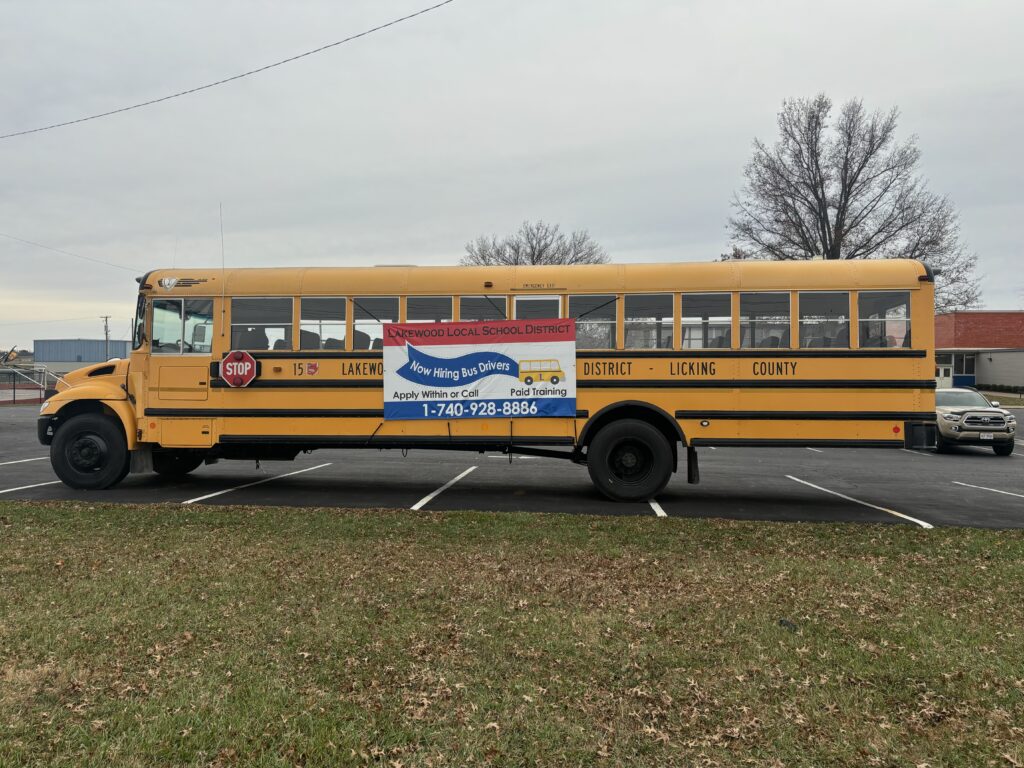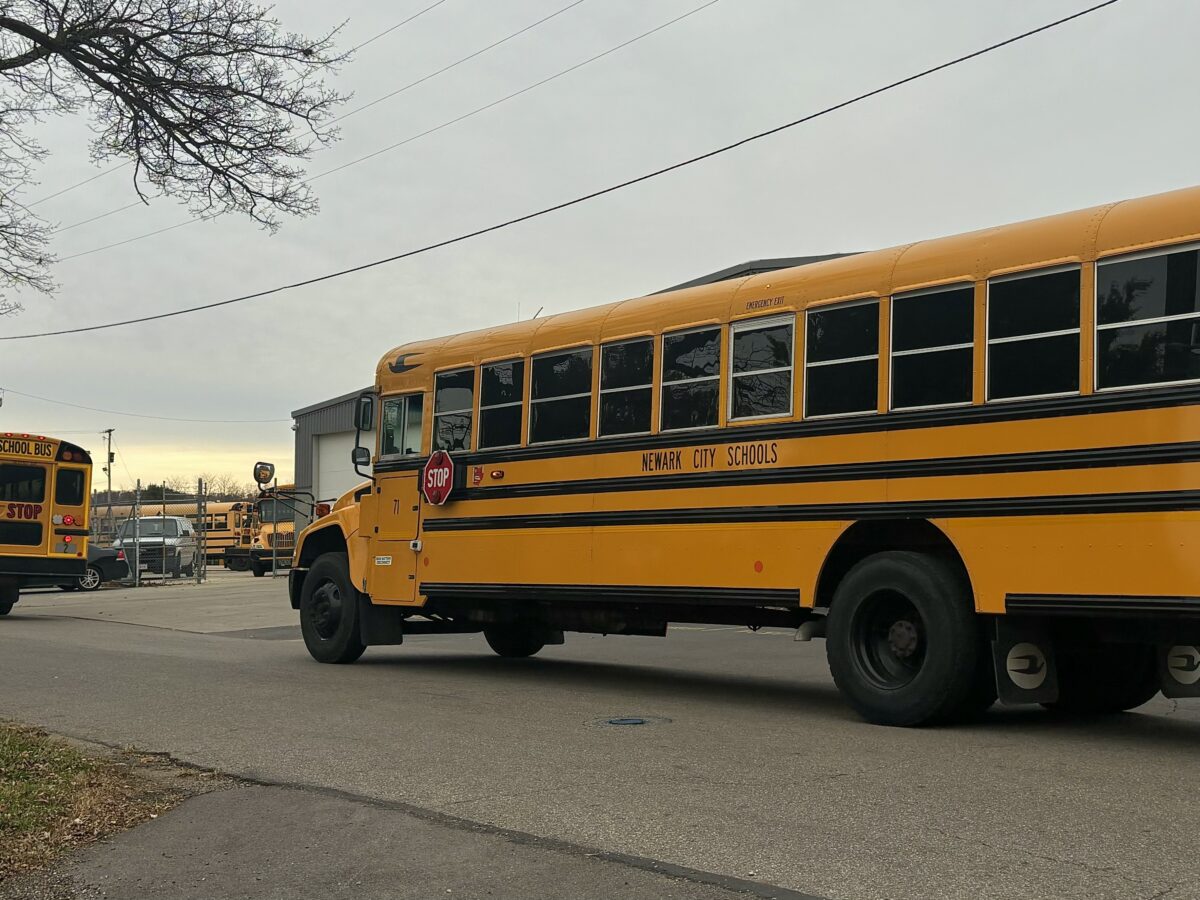David Stewart is wrapping up his lesson plan in his seventh period class when he gets the call.
“It’s down to you,” they tell him.
He finishes his instruction before making a quick exit to the row of buses parked behind Granville Middle School. After conducting bus supervision duties, he sits behind the wheel, ready to drive his route. Kids load into the bus, excited to return home to their parents.
Stewart is in his 37th year of teaching 7th grade social studies at Granville Middle School. He also works as a full-time substitute bus driver in the afternoon for Granville School District due to the shortage of drivers in Licking County.
Licking County is home to 10 school districts and part of seven others, many of which are falling below the number of drivers needed.
But driver shortages aren’t unique to Licking County. Survey results from the Ohio School Boards Association show just 7% of surveyed districts in Ohio are fully staffed with an adequate number of substitute drivers; nearly 33% of districts rely on substitute drivers and extra trips to transport students; and 13% of districts rely on office staff and mechanics to drive buses.
The same shortage is playing out across the nation. A report from the Economic Policy Institute (EPI) showed the number of school bus drivers in the United States fell more than 15% between 2019 and 2023. While the EPI reported some signs of progress in hiring new drivers over the last year — there were 12.2% fewer bus drivers on the road in September 2024 than in September 2019 — the group maintained that “the bus driver shortage remains severe,” and described the staffing as “woefully inadequate.”
Stewart earned his bus driving license in 1991.
“It started out simply to drive field trips because our total student population was small enough, we could put them on two school buses and do field trips,” Stewart said. “And then that has just kind of evolved into – well, you’ve got the license, keep the license. If we need you, we can certainly use you from time to time.”
The need for Stewart to drive the buses, however, has increased greatly since the COVID-19 pandemic began in 2020.
Scott Carpenter, transportation and safety supervisor for Granville School District, said Granville is understaffed by two drivers.
“When we came back after the pandemic, a lot of drivers simply decided not to drive,” Carpenter said.
Many of these drivers found other ways to supplement their income and then decided they didn’t want to return to driving buses.
Granville School District has enough drivers to cover its routes, but when even one isn’t present, the district has to scramble to find a substitute, such as Stewart.
“It’s a long day to teach class all day and then get right on a bus. But if it’s necessary, I actually have bus supervision duty at the end of the day, so it’s leave class, do the supervision, get on a bus and go,” Stewart said.
When he isn’t driving bus routes, he drives for athletics and field trips, or he focuses on his passion: teaching students.
Stewart, although unable to transport kids to school in the morning because he is a full time teacher, will always step in when needed to get the kids home safely.
“I know we struggled a great deal at the start of the year with even having people willing to do the job,” Stewart said. “We’ve had to realign routes even within a given day to get students home.”
Stewart emphasized that there are multiple other staff members, including individuals in the transportation department, who drive the buses when no one else can.
But when there aren’t enough drivers and the routes are as consolidated as they can be, the school districts have no choice but to close school.
That has happened in Licking County this school year.
On Sept. 17, the Lakewood Local School District closed for the day because there weren’t enough drivers to cover its routes, according to the Newark Advocate.
The district in the southern part of the county operates with 16 buses, and it was down five drivers that morning. Sometimes, when drivers are sick, they will split routes and divert students to other buses to get them to school or home. But with five drivers out, rerouting proved impossible.
“So we just ended up having to close, and that was hard because a lot of the community was not happy with that. But it is what it is,” said Bonita Jenkins, director of transportation at Lakewood Local Schools. “We closed when the roads were bad, [and] we had to close when there weren’t enough drivers.”
In response, Lakewood Local Schools administrators knew they needed more drivers.
They placed more advertisements and posted a big sign with red and blue decals – their school colors – asking for new bus drivers.

Now, two months after that school closure, Lakewood is about to start four new bus drivers. Jenkins is especially excited because she expects further growth in the area. This way, they are one step ahead.
“There’s some building going on in our district – apartment complexes that are coming. There’s one done right now, and they’re filling the apartments right now. So that’s going to add to maybe a new route here in the near future,” Jenkins said. “Even though we’ve had some trouble here and there the last year and a half, we’re on the upswing.”
William Bramblette, the transportation and maintenance supervisor at Heath City Schools, indicated another hurdle when searching for new drivers.
“It takes probably 60 to 90 days to get a bus driver trained and employed,” Bramblette said. “So unless I can find a driver who wants to come work for us who already has all of their certifications, it’s just a long process.”
But Bramblette emphasized that the training is crucial to the safety of the kids, and he does not want to compromise that.
Stewart said he believes the shortage of drivers is due to the responsibility of the position and the pay that comes with it.
“There are other jobs where you don’t have 70 kids sitting behind you going down the highway trying to maintain some sort of order,” Stewart said. “There’s a lot of real responsibility there to make sure that the children are safe – not only on the bus. When a child, especially the youngsters, gets off a bus, you don’t just let them get off a bus. You’ve got to engage with the parent, make sure a parent is there to provide for them.”
Though the responsibility is high, the EPI reports typical pay for driving school buses is not.
“The key issue fueling bus driver shortages today is low pay,” according to a Nov. 14 blog post from the EPI. “In 2023, the median school bus driver earned 43% less than the median weekly wage for all workers. And bus drivers’ pay is falling further behind: Weekly earnings for bus drivers have fallen 2.8% since 2019.”
Kim Bintz has been driving buses for Heath City Schools for 33 years. She started because she was struggling to find a babysitter for her kids, so she found a job going to and from school. She said she likes interacting with the kids on her route.
“I’ve got a pretty good set of kids on the bus,” she says with a laugh.
According to Bramblette, Heath City Schools is at least two full-time drivers short, similar to the Granville district. The district has 10-full time routes, and with 10 drivers, there’s no backup to cover a route when a driver falls ill, like Bintz did in mid-November.
Bintz, who was sick at home on Nov. 13, said she was worried about taking off because of the unavailability of substitutes to fill her place.
Bramblette estimates that they are in need of roughly 16% more staffing.
In preparation for the school year, Bramblette consolidated routes to make up for the shortage of drivers. Bramblette said he felt as if they were contacting parents every day with updates or changed bus routes. The district was able to hire another driver to help relieve some of the stress, but it wasn’t enough.
“I had to make this permanent change. I don’t have enough drivers to put these routes back to normal because if one person is sick, we’d have to then consolidate that route again at short notice, which would cause additional stress on the parents,” Bramblette said.
This leaves kids packed three to a seat and getting home later in the day. Bramblette also added that the overcrowding had led to an increase in discipline issues.
Newark City School District, with 52 bus drivers, is in a similar position. It has enough drivers to cover its routes, but it needs more full-time drivers to transport kids more efficiently.
Seth Roy, communications director of Newark City Schools, said that the recently renegotiated classified employee union contract, which resulted in an increase in pay for bus drivers, has helped the district retain drivers and bring in more.
Also, during the previous two springs, Newark City Schools have welcomed interested individuals to test drive the buses.
“We set up like a driver’s ed course that they can go through, because for some people, it’s a hurdle to just get them to think they can drive such a big vehicle,” Roy said.
Roy emphasized that the buses provide access to many students who otherwise would have no way to get to school.
“Our drivers do a great job building rapport with students. It makes a big difference in their lives to have a consistent person who’s there every day for them,” Bramblette said.
The bus drivers are the first face kids see when they head to school and the last when they leave for home. He further emphasized that that’s what makes switching routes and switching drivers often so difficult: The students lack consistency.
Education starts with getting the kids to school, Bramblette said.
“Even if you have the best teachers in the world, if we can’t get the kids to the school, they can’t take advantage of those educational opportunities,” he said.
Ella Diehl writes for TheReportingProject.org, the nonprofit news organization of Denison University’s Journalism program, which is supported by generous donations from readers. Sign up for The Reporting Project newsletter here.

